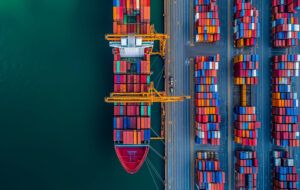
Blog
One Big Idea to Guard Against Supply Chain Crises
Two years into the pandemic, we have learned a lot about supply chain vulnerabilities and recommendations to address them. But there’s a lot we haven’t learned that could limit the impact of the next supply chain crisis — including how to spot the next supply chain crisis.
There is alarmingly little visibility into the U.S. supply chain. Companies have only narrow windows to view their link in the chain. This leaves massive blind spots that undercut our ability to build resiliency into the system.
It must change. And we must be bold in our approach. If companies had a way to share data with each other and leverage new, innovative technology, then you could make massive improvements to the reliability, sustainability and performance of supply chains.
It would take time and extensive cooperation from myriad stakeholders but developing a national freight data portal could fundamentally transform how 21st century supply chains operate. This data has the potential to empower everything from expedited border clearances to ingredient traceability.
The existence of national freight data could serve as the foundation for a “ground traffic control,” — a system akin to air traffic control — that could leverage data gleaned from supply chain stakeholders to create visibility that spots problems before they happen.
Here’s how we can capitalize on the idea.
Define and Engage Stakeholders
The supply chain is made up of thousands of businesses and individuals interacting with each other to source, manufacture and deliver goods and services around the world. Accordingly, there are a lot of stakeholders: maritime carriers, ports, rail companies, manufacturers, warehouses, distributors, shippers, third-party logistics providers, freight brokers, truck carriers, retailers, government officials and more. For a national freight data portal and, subsequently, ground traffic control to work, they all must be at the table. It’s a Herculean-sounding task but one that substantially benefits the stakeholders too as the end result allows them to improve their own business models.
Capitalize on Potential Through Data
The stakeholders defined in the first step then need to come together to share information through a national data portal — a secure, third-party, non-governmental exchange — which in turn would be shared back to supply chain stakeholders. Stakeholders would aspire to raise the bar for data standardization and adhering to common definitions. From there, the data exchange would serve as the foundation for ground traffic control, or a mass number of other potential applications including coordinating port operations, reallocating shipping containers and among others and its potential is massive.
- Creating trucking capacity without adding new drivers or trucks. Today, approximately 35% of the trucks on the road are empty and even more have underutilized capacity. But through data, we could tap that potential, helping alleviate the 80,000 truck driver shortage and new truck order backlog.
- Accelerating the movement of goods through ports. Today, empty containers are piling up on neighborhood streets in the Los Angeles area, while other supply chain stakeholders can’t find containers. That’s an avoidable mismatch that can be untangled by data sharing that could allocate shipping containers, reduce congestion and coordinate clearances.
- Equipping government with information to target investments. The passage of the Infrastructure Investment and Jobs Act has the long road of implementation ahead. Good data provides a map for investing in areas of greatest need that will benefit Americans most.
- Increasing consumer transparency. Robust and real-time data offers the potential to enhance traceability and transparency, pinpointing problems where they start and promoting consumer safety through faster and more targeted recalls.
- Reducing the environmental impact of the supply chain. Fewer trucks driving around empty and less waste and idle time in the supply chain will translate to reduced emissions and other environmental benefits.
Sounds Great. What’s the Catch?
Creating a national freight data portal is a big idea. Big ideas aren’t easy and this one demands the scale and convening power of the federal government.
There is precedent to build this system. A public private partnership model that encourages data sharing is already in use in other industries like Partnership for Analytics Research in Traffic Safety for the auto industry and Aviation Safety Information Analysis and Sharing for the aviation industry.
The first step is for the Biden-Harris administration to launch an executive initiative that convenes stakeholders to develop this idea. When formed, Congress must be engaged to fund the initiative and implementing programs. And to ensure there is end-to-end quality and coordination, the entire effort must be overseen by a federal office of supply chain. A national freight data portal commands that level of strategic governance and ongoing support, which is truly in the national interest. The benefit to the economy and to consumers far exceeds what it would take to get off the ground.
Make no mistake, this is a moonshot. It will be difficult to accomplish. But after two years of watching the consequences of a supply chain in crisis hit consumers, the choice to pursue it should be easy. Now’s the time to make big ideas a reality.
Published on March 7, 2022




